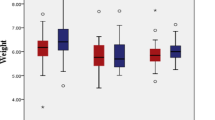Abstract
Experience with real data indicates that psychometric measures often have heavy-tailed distributions. This is known to be a serious problem when comparing the means of two independent groups because heavy-tailed distributions can have a serious effect on power. Another problem that is common in some areas is outliers. This paper suggests an approach to these problems based on the one-step M-estimator of location. Simulations indicate that the new procedure provides very good control over the probability of a Type I error even when distributions are skewed, have different shapes, and the variances are unequal. Moreover, the new procedure has considerably more power than Welch's method when distributions have heavy tails, and it compares well to Yuen's method for comparing trimmed means. Wilcox's median procedure has about the same power as the proposed procedure, but Wilcox's method is based on a statistic that has a finite sample breakdown point of only 1/n, wheren is the sample size. Comments on other methods for comparing groups are also included.
Similar content being viewed by others
References
Brown, B. M. (1982). Robustness against inequality of variances.Australian Journal of Statistics, 24, 283–295.
Cressie, N. A. C., & Whitford, A. B. (1986). How to use the two sample t-test.Biometrical Journal, 28, 131–148.
Dana, E. (1988).Salience of the self and the salience of a standard: Attempts to match self to a standard. Unpublished doctoral dissertation, University of Southern California, Department of Psychology.
DiCiccio, T. J., & Romano, J. P. (1988). A review of bootstrap confidence intervals.Journal of the Royal Statistical Society, Series B, 50, 338–370.
Donoho, D. L., & Huber, P. J. (1988). The notion of breakdown point. In P. J. Bickel, K. A. Doksum, & J. L. Hodges, Jr. (Eds.),A Festschrift for Erich Lehmann (pp. 157–184). Belmont, CA: Wadsworth.
Efron, B. (1982).The Jackknife, the bootstrap and other resampling methods. Philadelphia, PA: Society for Industrial and Applied Mathematics.
Efron, B. (1987). Better bootstrap confidence intervals.Journal of the American Statistical Association, 82, 171–185.
Hall, P. (1986). On the number of bootstrap simulations required to construct a confidence interval.Annals of Statistics, 14, 1453–1462.
Hall, P. (1988). On symmetric bootstrap confidence intervals.Journal of the Royal Statistical Society, Series B, 50, 35–45.
Hampel, F. R., Ronchetti, E. M., Rousseeuw, P. J., & Stahel, W. A. (1986).Robust statistics. New York: Wiley.
Harrell, F. E., & Davis, C. E. (1982). A new distribution-free quantile estimator.Biometrika, 69, 635–640.
He, X., Simpson, D. G., & Portnoy, S. L. (1990). Breakdown robustness of tests.Journal of the American Statistical Association, 85, 446–452.
Huber, P. (1964). Robust estimation of a location parameter.Annals of Mathematical Statistics, 35, 73–101.
Huber, P. (1970). Studentizing robust estimates. In M. L. Puri (Ed.),Nonparametric techniques in statistical inference (pp. 453–463). Cambridge, England: Cambridge University Press.
Huber, P. (1981).Robust statistics. New York: Wiley.
Kafadar, K. (1982). Using biweight M-estimates in the two-sample problem Part 1: Symmetric populations.Communications in Statistics—Theory and Methods, 11, 1883–1901.
Kendall, M. G., & Stuart, A. (1973).The advanced theory of statistics, Vol. 2. New York: Hafner.
Markatou, M., & Hettmansperger, T. P. (1990). Robust bounded-influence tests.Journal of the American Statistical Association, 85, 187–190.
Micceri, T. (1989). The unicorn, the normal curve, and other improbable creatures.Psychological Bulletin, 105, 156–166.
Parrish, R. S. (1990). Comparison of quantile estimators in normal sampling.Biometrics, 46, 247–258.
Patel, K. R., Mudholkar, S., & Fernando, J. L. I. (1988). Student's t approximations for three simple robust estimators.Journal of the American Statistical Association, 83, 1203–1210.
Ramberg, J. S., Tadikamalla, P. R., Dudewicz, E. J., & Mykytka, E. F. (1979). A probability distribution and its uses in fitting data.Technometrics, 21, 201–214.
Sawilowsky, S. S., & Blair, R. C. (1990).A more realistic look at the robustness of the independent and dependent samples t tests to departure from population normality (Tech. Rep.). Detroit: Wayne State University, College of Education.
Schrader, R. M., & Hettmansperger, T. P. (1980). Robust analysis of variance.Biometrika, 67, 93–101.
Sen, P. K. (1982). On M tests in linear models.Biometrika, 69, 245–248.
Sheather, S. J., & Marron, J. S. (1990). Kernel quantile estimators.Journal of the American Statistical Association, 85, 410–416.
Shoemaker, L. H., & Hettmansperger, T. P. (1982). Robust estimates and tests for the one- and two-sample scale models.Biometrika, 69, 47–54.
Shorack, G. R. (1976). Robust studentization of location estimates.Statistical Neerlandica, 30, 119–141.
Staudte, R. G., & Sheather, S. J. (1990).Robust estimation and testing. New York: Wiley.
Tan, W. Y. (1982). Sampling distributions and robustness of t, F and variance-ratio in two samples and ANOVA models with respect to departure from normality.Communications in Statistics—Theory and Methods, 11, 2485–2511.
Tiku, M. L. (1982). Robust statistics for testing equality of means or variances.Communications in Statistics—Theory and Methods, 11, 2543–2558.
Tukey, J. W. (1960). A survey of sampling from contaminated distributions. In I. Olkin, S. Ghurye, W. Hoeffding, W. Madow, & H. Mann (Eds.),Contributions to probability and statistics (pp. 448–485). Stanford, CA: Stanford University Press.
Welch, B. (1937). The significance of the difference between two means when the population variances are unequal.Biometrika, 29, 350–362.
Wilcox, R. R. (1987). New designs in analysis of variance.Annual Review of Psychology, 38, 29–60.
Wilcox, R. R. (1990a). Comparing variances and means when distributions have non-identical shapes.Communications in Statistics—Simulation and Computation, 19, 155–173.
Wilcox, R. R. (1990b). Comparing the means of two independent groups.Biometrical Journal, 32, 771–780.
Wilcox, R. R. (1990c). Comparing biweight measures of location in the two-sample problem.Communications in Statistics—Simulation and Computation, 19, 1231–1246.
Wilcox, R. R. (1991). Testing whether independent groups have identical medians.Psychometrika, 56, 381–395.
Yoshizawa, C. N., Sen, P. K., & Davis, C. E. (1985). Asymptotic equivalance of the Harrell-Davis median estimator and the sample median.Communications in Statistics—Theory and Methods, 14, 2129–2136.
Yuen, K. K. (1974). The two-sample trimmed t for unequal population variances.Biometrika, 61, 165–170.
Zarembra, S. K. (1962). A generalization of Wilcoxon's test.Monatshefte fur Mathematik, 66, 359–370.
Author information
Authors and Affiliations
Rights and permissions
About this article
Cite this article
Wilcox, R.R. Comparing one-step m-estimators of location corresponding to two independent groups. Psychometrika 57, 141–154 (1992). https://doi.org/10.1007/BF02294663
Received:
Revised:
Issue Date:
DOI: https://doi.org/10.1007/BF02294663




